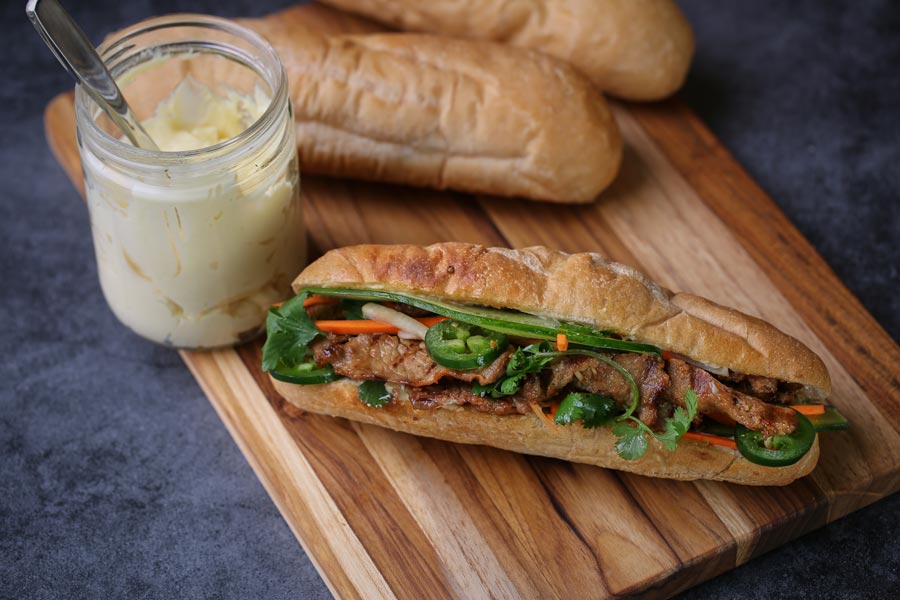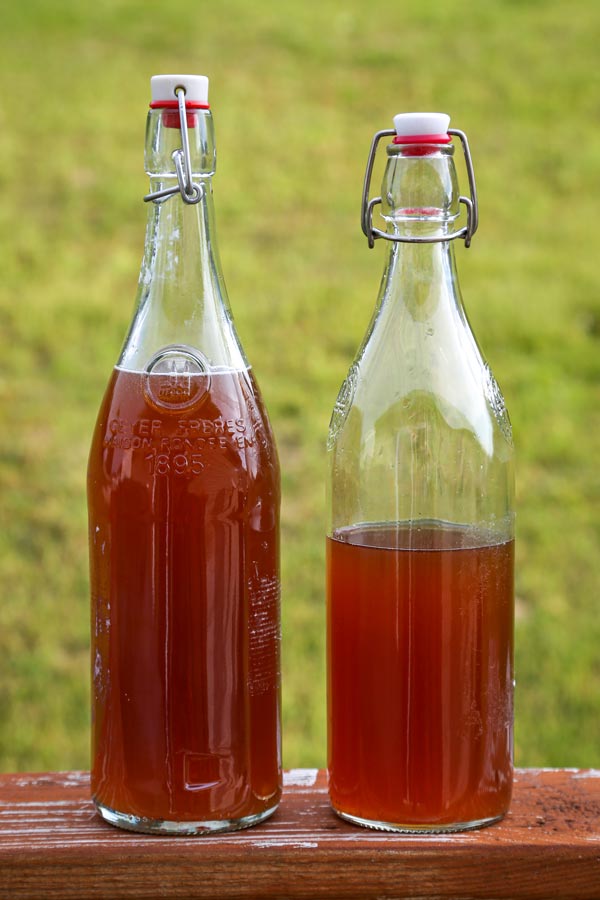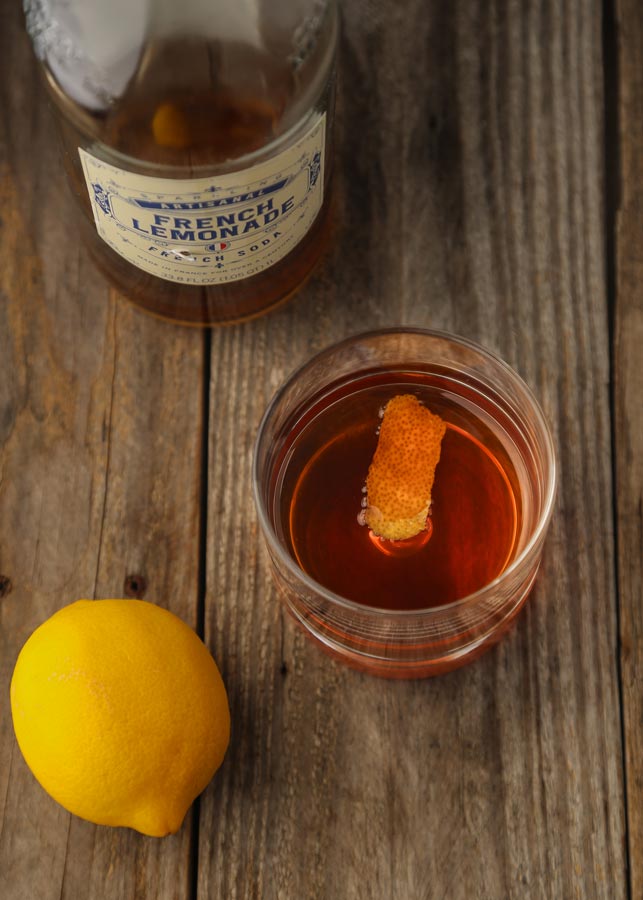Rations and Intoxicants
By Jenny Nguyen-Wheatley
Grilled Wild Boar Bánh Mì
I typically eat lighter during the summer months, and many Vietnamese dishes check that box. My family is from South Vietnam, and although both my mother’s and father’s ancestral homes enjoy the benefits of the coastal breezes that come into Nha Trang, we have to fly into Saigon whenever we visit, and the air in the interior is always stifling. It seems like no matter what time of year I check, daytime temperatures in Saigon hover in the 90s, along with humidity that’ll make you sweat even under a cold shower in January.
With a climate that can be sweltering year-round, the food of Vietnam isn’t known for being heavy. Even our iconic bread–called bánh mì–would be considered light next to its precursor. Inspired by and created during France’s colonization of Vietnam, the Vietnamese baguette is markedly more delicate than its imperial counterpart.
My father holds onto fond memories of buying bánh mì on the street corner on his way to school as a boy. Although he could only afford a splash of hot cooking liquid from the cart’s pot of braised pork belly inside his bread, at 82 years old this remains one of my dad’s favorite food memories. He can still recall the smell of fresh yeasty bread mingling with savory aromas steaming from the braising pot. “When I had spare change, that was breakfast,” he says dreamily. “It was such a treat.”
Vietnamese-French bread is the ideal sandwich bread. When fresh, its thin, golden-crispy crust offers a satisfying crunch that yields to every bite. And unlike traditional French bread, its crumb is tender and airy, not dense–perfect for filling with generous amounts of meat and vegetables, while inviting warm juices and sauces. Delicious stuffed or simply eaten with butter, spreadable cheese, or a few dashes of Maggi sauce–one of my mom’s favorite snacks–there’s nothing like enjoying fresh-from-the-oven bánh mì by itself. You always have to sacrifice a piece while traveling home from the bakery–at least I could never help myself.
Now that I’ve made you hungry, you might be expecting a recipe; unfortunately, I am going to disappoint. Vietnamese families don’t typically bake their own bread. Visiting the neighborhood bakery while on a grocery run is a part of Vietnamese life. That’s how my family had bánh mì while I was growing up–and having made our home in the Little Saigon district of Southern California, good bánh mì wasn’t hard to come by. I’m glad to see more bánh mì shops opening in the metro areas of my home state of Nebraska these days. Unless you live in the boonies, I bet there’s a shop near you. Ask for the bread by itself.
Bánh mì can be filled with anything. Vietnam’s signature sandwich includes an assortment of thinly sliced cold cuts, generous amounts of pork liver pâté, and full-fat mayonnaise, and it is always garnished with plenty of carrot and daikon pickles and fresh herbs for balance. Making Vietnamese cold cuts isn’t something that I’ve delved into yet, so for this issue’s recipe, I’m mirroring another classic: grilled pork bánh mì. Pork is used heavily in Vietnamese cooking, and luckily, I just recently came into some wild boar meat from Texas.
Although leaner and a bit tougher than domestic pork, cook wild boar similarly. The same rules apply: Cook to at least 145 degrees to kill trichinosis, brine or marinate when possible for juiciness and tenderness, and don’t overcook the meat unless you’re going to braise it.
 I I referenced Andrea Nguyen’s Viet World Kitchen blog for her full-fat mayonnaise recipe.
I I referenced Andrea Nguyen’s Viet World Kitchen blog for her full-fat mayonnaise recipe.
Grilled Wild Boar Bánh Mì
Servings: 4 sandwiches
Prep Time: Overnight
Cooking Time: 15 minutes
Ingredients:
– 1½ pounds of wild boar loin
– 4 bánh mì rolls*
– Sliced cucumber
– Sliced jalapeño
– Small bunch of cilantro
Marinade
– 4 cloves of garlic, minced
– 2 shallots, minced
– 2 tablespoons of brown sugar
– ½ teaspoon of freshly ground pepper
– 2 tablespoons of fish sauce
– 1 tablespoon of Shaoxing rice cooking wine (not vinegar)
– 2 tablespoons of canola oil, plus extra
– 2 tablespoons of dark soy sauce
Pickled Carrot & Daikon (makes extra)
– 1 large carrot, peeled and julienned
– Equal amount of daikon radish, peeled and julienned
– 1 teaspoon of sea salt
– 1 tablespoon + 2 teaspoons of white sugar
– 1 cup of white wine vinegar
Full-Fat Mayonnaise (makes 1 generous cup)
– 2 egg yolks
– ½ teaspoon of kosher salt
– 1 tablespoon of lime juice
– ½ teaspoon of Dijon mustard
– 2 teaspoons of white wine vinegar
– 1 cup of canola oil
Special Equipment: skewers
* If there is no Vietnamese bakery or bánh mì shop near you, substitute with Mexican bolillo rolls.
1. The night before, remove silver skin on loin and thinly slice against the grain. In a small bowl, combine marinade ingredients and add pork to coat. Cover and refrigerate for 8 hours.
2. To make pickles, sprinkle sea salt and sugar over the julienned carrot and daikon. Submerge with white wine vinegar and stir. Allow to sit for at least 30 minutes before serving, or refrigerate in a jar until ready to eat. This quick pickle will keep for 2 weeks in the refrigerator.
3. If using wooden skewers, soak in water for 30 minutes prior to grilling. Prepare grill for direct, high-heat cooking.
Meanwhile, make the full-fat mayonnaise: Combine egg yolks, salt, lime juice, Dijon mustard, and white wine vinegar in a food processor and pulse 4 to 5 times to combine. Then with the machine running on low, gradually add canola oil in a thin, steady stream and whip until thickened. If your mayonnaise breaks, whip in an extra egg yolk. Keep mayonnaise cold until ready to use.
4. Thread marinated wild boar meat onto skewers and brush with canola oil. Grill on high heat for caramelization all over, flipping halfway through; this shouldn’t take long. Split open slightly toasted bánh mì bread and spread mayonnaise on the inside. Fill with grilled wild boar, cucumber, jalapeño, a few whole sprigs of cilantro, and pickled carrot and daikon. Serve immediately.
“Ditch Water” Plum Brandy
Ingredients:
– 6 pounds of ripe wild plums
– 3½ cups of Sugar in the Raw (turbinado sugar), plus extra
– White sugar, optional
– About 1 bottle of brandy
– Twist of lemon zest
Special Equipment: cheesecloth, rubber band, large glass jar
1. Only rinse plums if they are noticeably dirty, but do not rub off the bloom–the white, waxy coating on the fruit. The bloom contains wild yeast, which helps fermentation. Slice each plum to allow juices to escape.
2. Transfer cut plums to a bowl and coat with raw sugar. Add more sugar as needed; the fruit needs to be well coated. Transfer plums to a large jar, allowing at least a couple inches of headspace. Then use a potato masher or something similar to push down the fruit to help release juices. After a few hours to a day, juices should completely submerge plums. If not, add water, which prevents the fruit from spoiling. Use something heavy to weigh down the fruit.
3. Use cheesecloth to cover the jar and secure with a rubber band. Store in a cool, dry place to ferment for 2 weeks. The amount of bubbling and foaming will vary. If you start to see mold, scoop it out when it’s in its white stages. Don’t wait until the mold gets black, which is toxic.
4. Strain the fermented plum juice through cheesecloth and discard the fruit and seeds. Transfer to clean jars or bottles and add equal parts brandy. If needed, add white sugar to taste.
Chill and enjoy the brandy now or, for a clearer drink, allow sediment to form at the bottom and siphon off the clear liquid into different bottles. Keep refrigerated.
I enjoy this plum brandy chilled with a twist of lemon zest on top. It’s also refreshing over ice.
Hunter, Angler, Gardener, Cook: A Conversation with Hank Shaw
Food For Hunters: The Wild Game Cooking of Jenny Nguyen-Wheatley





